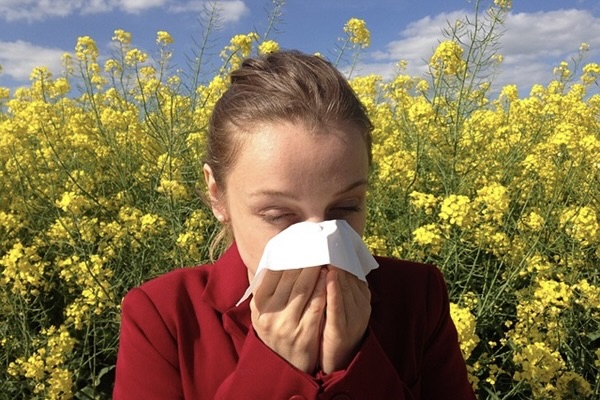 Credit: Pixabay
Credit: Pixabay
Hay fever is an allergic reaction to plant and tree pollen which affects millions of people worldwide. If you suffer from it, you will know full well how annoying and debilitating it can be. During the months of March, April and May - peak pollen season - I have to take antihistamines every day and carry around a packet of tissues to deal with watery eyes and a very runny nose. It is like catching a cold from nature itself.
Hay fever, also known as allergic rhinitis, apparently affects around 40% of people and is caused when a person comes into contact with an allergen (pollen) which their immune system mistakenly identifies as a threat. This makes the immune system produce an antibody called immunoglobulin to neutralise it. The antibodies attach themselves to immune cells, called mast cells, which are located in the nose, eyes and lungs and, when the allergen comes into contact with the antibodies they trigger the release of histamine which then causes inflammation and the typical symptoms of hay fever.
Personally, I suffer from itchy eyes, runny nose, sneezing fits, lethargy and an inescapable sensation of feeling unwell and run down as my body reacts to the invisible invasion of irritants floating around in the air. I only discovered my negative reaction to pollen when I arrived at Schipol Airport for the first time back in 1998 and proceeded to have a sneezing fit for fifteen minutes, much to the amusement of those around me. Growing up in Scotland, I grew up in a consistently windy environment which ensured that the pesky pollen never really had the opportunity to inflict its nastiness upon me. But, in Luxembourg, I very much dread the annual coming of Spring and the sight of several millimetres of sticky pollen coating my patio furniture and windows. This extends all the way through to August, as grass pollenation shifts to tree pollenation and then the pollenation of various weeds and herbaceous plants.
There are a wide variety of antihistamines which sufferers can purchase, whether from a pharmacist or online and, as far as I am aware, each person afflicted with hay fever experiences different results with antihistamines. Essentially, there is no golden bullet when looking for relief. I generally take bilastine, which is an antihistamine sold under various brand names. It does provide relief but, like most antihistamines, they lose their effectiveness over time as the immune system becomes accustomed to them.
Luxembourg has an excellent website/application (pollen.lu) for tracking pollen levels throughout the year. It provides detailed information on daily levels of a variety of pollens and is a useful tool in confirming that, yes, I am feeling a bit crappy today because of the high levels of pollen present in the air. However, it is also becoming something of a horror show. The app categorises any levels of pollen above 51 as “high”. So, imagine my horror when I recently checked the app and it informed me that the level of oak pollen for that day was at 3,256. At first I just thought it was my inflamed and weeping eyes skewing the values on my phone screen but, yes, it truly was displaying a level of 3,256. A value not to be sniffed at. It made me feel as if the terrible M. Night Shyamalan film The Happening, with plants silently turning on humans and inducing mass suicides, was actually oddly prophetic. Sadly, there is no antihistamine for that film. But did it have a point? Well, kind of.
For the past few years, Japan has been experiencing record levels of tree pollen. The levels have been so high that its government has declared it as a health issue that requires urgent government action. Unsurprisingly, it is not really the fault of nature but has actually been caused by the unnatural prevalence of Cedar and Cypress trees in Japan. After World War II, Japan undertook a reforestation programme which involved the planting of vast swathes of Cedar and Cypress trees to provide materials for the country’s construction industry. This was fine until the 1970s, when the cost of importing construction materials dropped considerably and fewer trees were cut down. Left to grow unchecked, it has resulted in the annual unleashing of record levels of tree pollen and has now reached a point where some companies in the country provide a “hay fever allowance” to employees to spend on prescription treatments and clinic visits. A 2020 study of Japanese hay fever sufferers noted that approximately 80% of respondents believe that the symptoms of hay fever made them less productive.
We live in a modern society which is driven by productivity. We live in an age where solutions to many health problems exist. We live in a country where 35% of its landmass is covered with forest. Forest which produces pollen over several months of the year. Yet, the effects and implications of hay fever seem, to me, to still be regarded by many as a genetic quirk which some people just have to get on with. If pollen truly affects the productivity of a high number of workers in Japan, why would the levels in the Grand Duchy not be similar or even higher due to the number of non-native residents we have here? We love our forests in this country and rightly so. Not only are they an essential and celebrated part of the country’s ecosystem, but they are also recognised as being incredibly beneficial for people’s mental health and wellbeing. But, with the ever-increasing problems of climate change the impact of hay fever is a problem which is only going to become worse. A recent study by the University of Manchester found that the prevalence of hay fever has risen by 33% in the past 20 years, an increase attributed to various factors, such as urbanisation and, unsurprisingly, climate change. But what can we do?
The first thing is to take advantage of the allergy testing available through the health system in Luxembourg. I was tested for other reasons but the results reflected what I had already experienced during my time here. This helped as much from a mental perspective as a medical perspective and reinforced my determination to be aware of when pollen would arrive and ensure that I always have antihistamines available to me. If you exercise outdoors, study the surroundings of your activities and understand that it is better for your health to not go for a run through a forest when the pollen levels are high. Allergen immunotherapy does exist and can “reprogramme” the immune system to accept certain allergens and not react by producing antihistamines, but results can vary and the duration of treatments can extend into years.
Ultimately, it is essential to recognise if hay fever is impacting you. It is easy to dismiss some of the symptoms as just being a result of overworking or being a touch run down but I can assure you that, particularly over a prolonged period, it can be debilitating and depressing if you do not know why you feel off-colour when the sun is shining and those around you seem to be unaffected.








